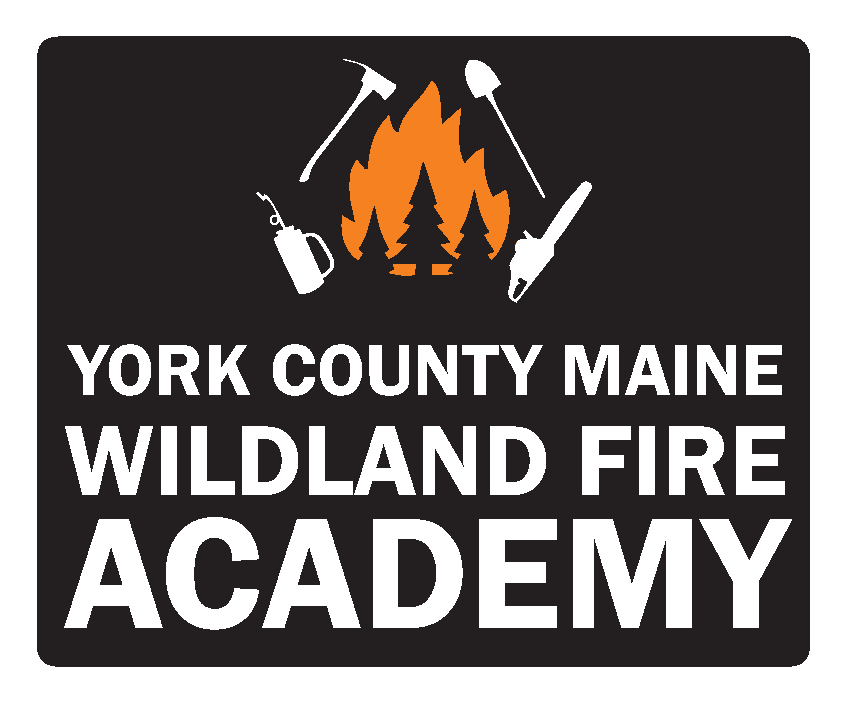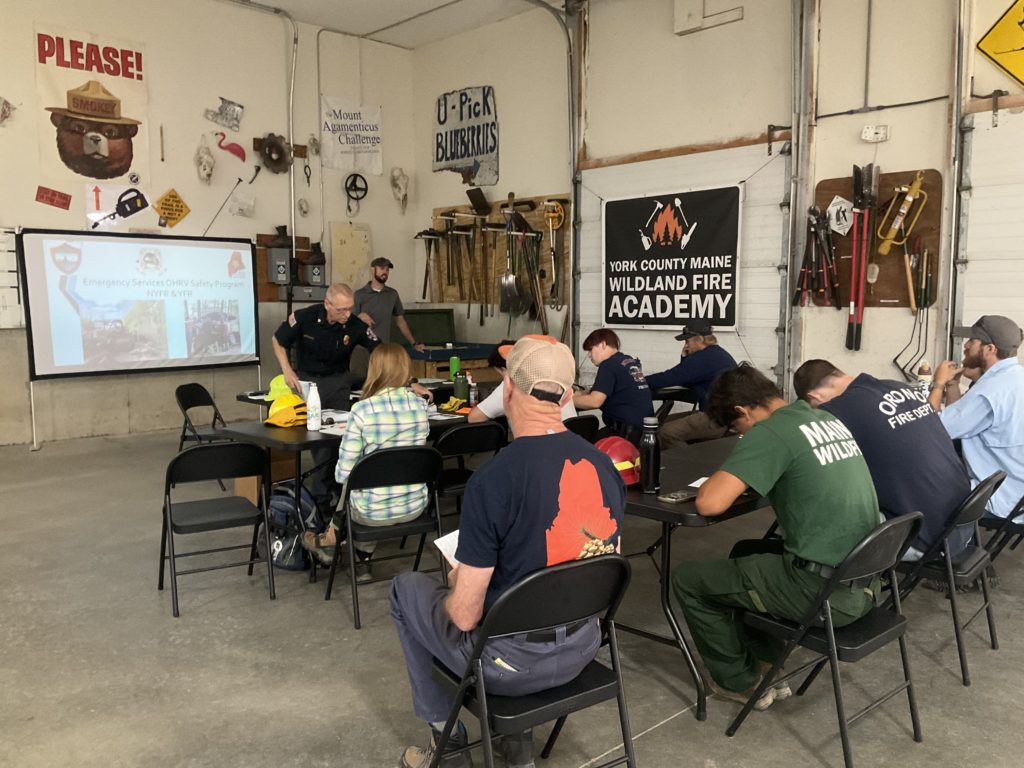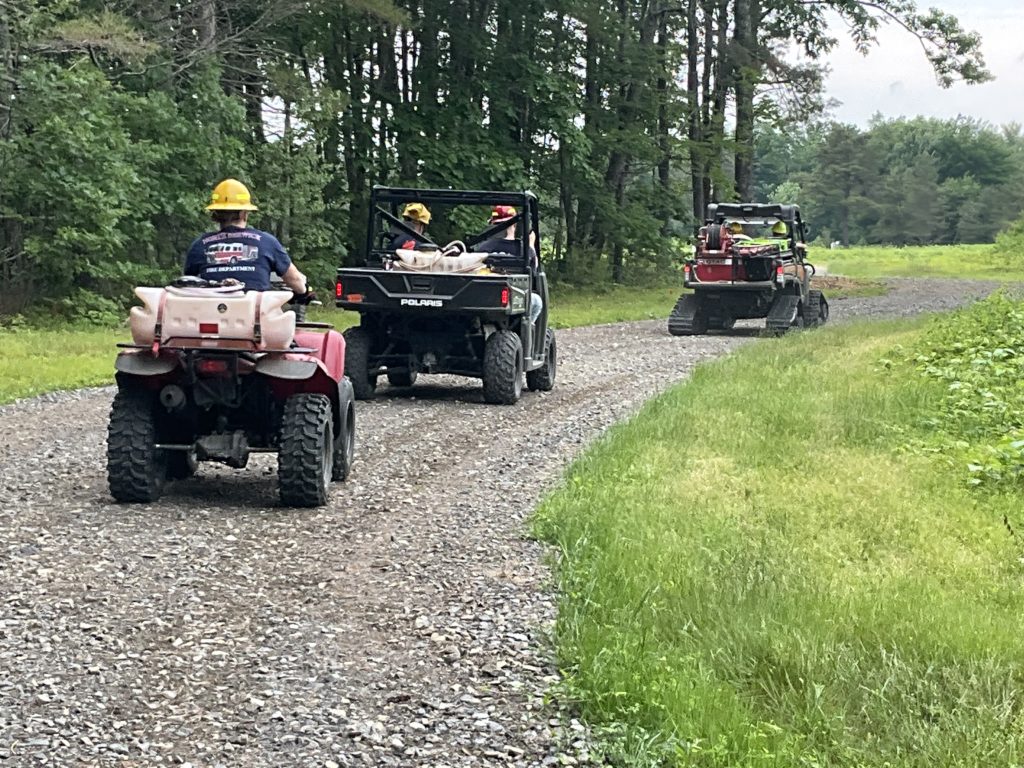Collaboratively Building (local) Capacity to Reduce Wildfire Risk
 Written by Polly Weigand
Written by Polly Weigand
In 2021, the Guild in partnership with the Maine Prescribed Fire Council, The Nature Conservancy, USDA- Forest Service, Maine Forest Service, Maine Army National Guard, York County Emergency Management Agency, and the York County Community College successfully secured US Forest Service Wildfire Risk Reduction grant funding. The aim was to advance the development of a Maine-Massabesic Region Community Wildfire Protection Plan and implement a suit of Wildfire Risk Reduction practices. This June, after many years of collaborative planning, the inaugural York County Maine Wildland Fire Academy marked a significant interagency collaborative achievement.
Six classes, including Basic Wildland Firefighter Training (s130-190), Portable Pumps and Water Use (s211), UTV Operator Safety, First Aid/ CPR, and Firefighter Type 1 (s131 and GT 131) were offered to provide the mandatory training, foundational knowledge, technical skills, and leadership training for beginning and early career wildland fire fighters as well as structural firefighters. Enrollment response was sufficient to host all the classes.
 The week’s event was a resounding success! After all the fire line was dug, hose backhauled and rolled, pumps and hand tools stashed back in the cache, UTV operations concluded, CPR skills honed, practice fire shelters refolded (which is by far the biggest accomplishment), and required paperwork submitted, over 30 newly qualified wildland fire fighters (FFT2) were already eagerly anticipating the opportunity to step up to the fire line to put their new skills to work. Of the other 47 attendees who were already qualified as FFT2, a total of 16, 10, and 8 individuals completed s211, UTV operations, and First Aid/CPR courses, respectively. Equally beneficial to building capacity, 11 Firefighter Type 2’s were able to open their squad boss task book and demonstrate their tactical and leadership competencies to serve as a Squad Boss (FFT!),
The week’s event was a resounding success! After all the fire line was dug, hose backhauled and rolled, pumps and hand tools stashed back in the cache, UTV operations concluded, CPR skills honed, practice fire shelters refolded (which is by far the biggest accomplishment), and required paperwork submitted, over 30 newly qualified wildland fire fighters (FFT2) were already eagerly anticipating the opportunity to step up to the fire line to put their new skills to work. Of the other 47 attendees who were already qualified as FFT2, a total of 16, 10, and 8 individuals completed s211, UTV operations, and First Aid/CPR courses, respectively. Equally beneficial to building capacity, 11 Firefighter Type 2’s were able to open their squad boss task book and demonstrate their tactical and leadership competencies to serve as a Squad Boss (FFT!),
You may have wondered when the topic of wildfire was first referenced, why in Maine? Indeed, the “way that life should be” state has the propensity to be scorched by wildfire. Especially in the Massabesic region of southern Maine. York County was chosen as the Academy location, being centrally located within the greater Massabesic region that extends into New Hampshire. It is a fire adapted landscape, which supports some of the highest levels of rare and unique species assemblages within the prominent sandplain grassland, heath, and pine barren dominated plant communities, making it ecologically distinct and more prone to wildfire than the more abundant mixed conifer forests commonly associated with these two states.
 The Massabesic Region of Maine also has a long history of large and catastrophic wildfires, including the “Great Fire of 1947” which consumed more than 200,000 acres, took 16 lives, and destroyed over 1,000 homes. As the second most populous county in Maine, due to its proximity to Boston, the region continues to experience a sustained risk of wildfire with the expansion of wildland urban interface, densely stocked forests, and high recreational use.
The Massabesic Region of Maine also has a long history of large and catastrophic wildfires, including the “Great Fire of 1947” which consumed more than 200,000 acres, took 16 lives, and destroyed over 1,000 homes. As the second most populous county in Maine, due to its proximity to Boston, the region continues to experience a sustained risk of wildfire with the expansion of wildland urban interface, densely stocked forests, and high recreational use.
Building capacity for wildfire risk reduction through locally accessible wildfire suppression and prescribed fire management training via the York County Maine Wildland Fire Academy is the most recent accomplishment to be recognized under this wildfire risk reduction grant. Ensuring ready access to water resources by Fire Departments through the installation of dry hydrants; conducting fuel reduction and rearrangement through selective thinning and mastication within Kennebunk plains forests; and outfitting fire department staff with appropriate wildland fire personal protective gear are other funded initiatives. The final component, currently in draft, is the development Massabesic Community Wildfire Protection Plan.
 As the grant ends this fall, the Guild and the interagency partnership recognizes the significant investments and the value of the established collaborative framework. Impressive expertise, funds, staff, equipment, and facilities have been leveraged through this, and planning has started already for next year’s York Maine Wildland Fire Academy.
As the grant ends this fall, the Guild and the interagency partnership recognizes the significant investments and the value of the established collaborative framework. Impressive expertise, funds, staff, equipment, and facilities have been leveraged through this, and planning has started already for next year’s York Maine Wildland Fire Academy.
